Hiyoshi Taisha Shrine 日吉大社
|
Title   • File Name • File Name   • Date • Date   • Position • Position   |
|

Hiyoshi Taisha Shrine at the foot of Mt. Hie in Otsu, Shiga Prefecture is the head shrine for all Hiyoshi, Hie, and Sanno Shrines in Japan (around 2,000). Hiezan Sakamoto Station on the JR Kosei Line and Keihan Line's Sakamoto Station are nearest.
|
|

Hiyoshi Taisha's tea field, Japan's oldest.During the latter half of November, Hiyoshi Taisha has 3,000 maple trees lit up at night 5:00 pm–8:30 pm. Even the green leaves look great against the dark sky. Info in Japanese:
http://hiyoshitaisha.jp/event/momiji/
|
|

Another torii on the Sando road leading to Hiyoshi Taisha. This neighborhood is called Sakamoto which is noted for traditional architecture.
|
|

Torii at Hiyoshi Taisha Shrine. Two of the shrine's main structures are National Treasures.
|
|

The first torii you see when you enter the sprawling shrine grounds. Hiyoshi Taisha worships the mountain god of Mt. Hiei and the god protecting the nation. MAP
|
|

Torii at night in autumn. Hiyoshi literally means "Good Day" or "Fortunate Day." People pray here to have a good day. Having a good day every day leads to a good life. Taisha means "grand shrine."
|
|

Jizo 早尾地蔵尊
|
|

Jizo statue
|
|
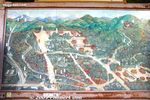
Map of Hiyoshi Taisha Shrine at the foot of Mt. Hiei. It is a complex of the so-called Seven Sanno Shrines, including two shrines designated as National Treasures. There are also 14 lesser shrines. Most things are within easy walking distance.
|
|

A small admission is charged to enter the shrine. 求法寺
|
|

Omiya Bridge happens to be an Important Cultural Property. 大宮橋
|
|

Omiya Bridge at night in autumn when they light up the leaves.
|
|

Entering Nishi Hongu Shrine.
|
|

Approaching Sanno Torii
|
|

Sanno Torii has a unique shape. The triangular gable on top represents the integration of Buddhism's Womb Realm and Diamond Realm with Shinto. 山王鳥居
|
|

Sanno Torii lit up in autumn at night in Nov. 山王鳥居
|
|

Hiyoshi Taisha once had as many as 108 shrines, but Oda Nobunaga torched all of it along with Enryakuji temple on Mt. Hiei in the 16th century. The buildings were since rebuilt.
|
|

Sacred Monkey cage on left and Sacred Horse on the right (dummy horse).
|
|

Sacred Monkey. The monkey is the shrine god's messenger.
|
|

Kep walking straight and you will come to this Romon Gate at Nishi Hongu Shrine. 楼門
|
|
|
|

Hiyoshi Taisha's Romon Gate at Nishi Hongu Shrine is an Important Cultural Property. 楼門
|
|
|
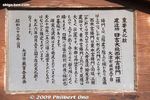
About the Romon Gate in Japanese.
|
|

Monkey sculpture on all four corners of the Romon Gate at Nishi Hongu.
|
|
|
|
|

Nishi Hongu Haiden Hall
|
|

Directly behind the Haiden is the Nishi Hongu Honden Hall
|
|

Portable shrines (called shinyo instead of mikoshi) are placed in the Haiden for the Sanno-sai Festival.
|
|
|

Hiyoshi Taisha's Nishi Hongu Honden Hall, a National Treasure. It is only one of three buildings in Japan which represent the Hie-zukuri (日吉造り) architectural style. Higashi Hongu and Usagu and the two other shrines in this style.西本宮 �
|
|
|
|
|

Nishi Hongu Honden Hall worships the god (Onamuchi-no-kami) protecting the nation. This current structure was built in 1586. 西本宮 本殿
|
|
|
|
|
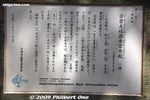
About Nishi Hongu Honden Hall
|
|

Next to Nishi Hongu is Usa-gu Shrine.
|
|

Usa-gu Shrine is also in the Hie-zukuri style, but smaller than Nishi Hongu. Important Cultural Property built in 1598.
|
|
|

Usa-gu Shrine Honden 宇佐宮 本殿
|
|
|
|

Secondary shrines in need of repair (donations welcome).
|
|

Way to Shirayama-gu Shrine.
|
|
|

Shirayama-gu Shrine Haiden
|
|

Shirayama-gu Shrine Honden Hall. Important Cultural Property built in 1598. 白山宮 本殿
|
|

Near Nishi Hongu is this small river and restaurant.
|
|
|

Nishi Hongu is also lit up at night during autumn.
|
|
|

Hiyoshi Taisha's Sanno Torii rear view.
|
|

Ninomiya Bridge leading to Higashi Hongu Shrine. 二宮橋
|
|
|
|
|
|

Path to Higashi Hongu Shrine.
|
|

Sacred Rock for the monkey spirit. 猿の霊石
|
|

Romon Gate to Higashi Hongu
|
|
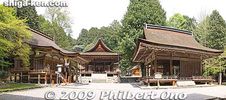
In the middle is the Haiden for Higashi Hongu.
|
|

Hiyoshi Taisha's Higashi Hongu Shrine Honden, a National Treasure. This shrine worships the mountain god (Oyamakui-no-kami) of Mt. Hiei. Built in 1595. 東本宮 本殿 国宝
|
|
|
|
|
|

Rear of Higashi Hongu Honden Hall. You can see that the veranda in the center is slightly elevated. This makes it different from Nishi Hongu.
|
|
|

Thatched roof of Higashi Hongu.
|
|

Right side of Higashi Hongu Honden. The front looks almost identical to Nishi Hongu.
|
|
|
|
|
|
|
|
|
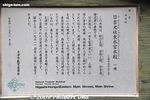
About the Higashi Hongu in Japanese.
|
|

Kamei Sacred Well
|
|
|
|
|

Romon Gate rear
|
|

Path to Mt. Hachioji where there are two more shrines.
|
|

Portable shrine storehouse
|
|

Inside portable shrine storehouse where retired portable shrines are kept. They are Important Cultural Properties.
|
|
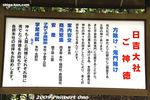
What to pray for at Hiyoshi Taisha.
|
|
|
|

Yomiya-jo
|
|

Way to Hiyoshi Toshogu, in the same direction as the Hieizan cable car.
|
|
|

Hiyoshi Taisha's Toshogu Shrine is a lesser shrine (massha 末社), a short walk from the main area of Hiyoshi Taisha.
|
|

This is a must-see shrine. Very ornate and colorful, similar to Toshogu Shrine in Nikko. Important Cultural Property.
|
|
|
|
|

The gate gives a hint of what's to come.
|
|
|

The Gongen-zukuri architectural style is employed. This shrine was the inspiration for the more famous Toshogu Shrine in Nikko (Tochigi) and Kunozan Shrine in Nihondaira, Shizuoka.
|
|

Unlike the other shrines, you can actually go inside this shrine hall.
|
|
|
|
|
|
|
|
|
|
|
|
|
|
|
|
|
|
|
|
|

Inside looks like brand new.
|
|
|
|
|
|
|
|
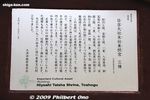
About Toshogu Shrine in Japanese.
|
|

The shrine also has a torii gate on the lake shore, next to Sakamoto Castle.
|
|

It is actually a boat dock on Lake Biwa.
|
|
|
|

Hiyoshi Taisha Shrine's boat dock is used during the Sanno Festival when they carry the portable mikoshi shrines on a boat.
|
|
|
|
|
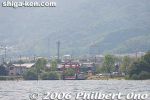
Hiyoshi Taisha's waterfront torii as seen from the lake.
|
|

Hiyoshi Taisha's waterfront torii as seen from the lake.
|
|
|
|
|
|